大学院説明会
特設ウェブサイト
- トップ
- インタビュー
- 酒井 寿郎
「知りたい心」が全てのエネルギー源
好奇心をもって真理を追求し
医学生理学の発展に寄与してほしい
“Curiosity” is the key energy for science
- 医科学専攻
- Medical Sciences
- 分子代謝生理学分野 教授
- Division of Molecular Physiology and Metabolism Professor
- 酒井 寿郎
- Juro Sakai
- 2020.05.29
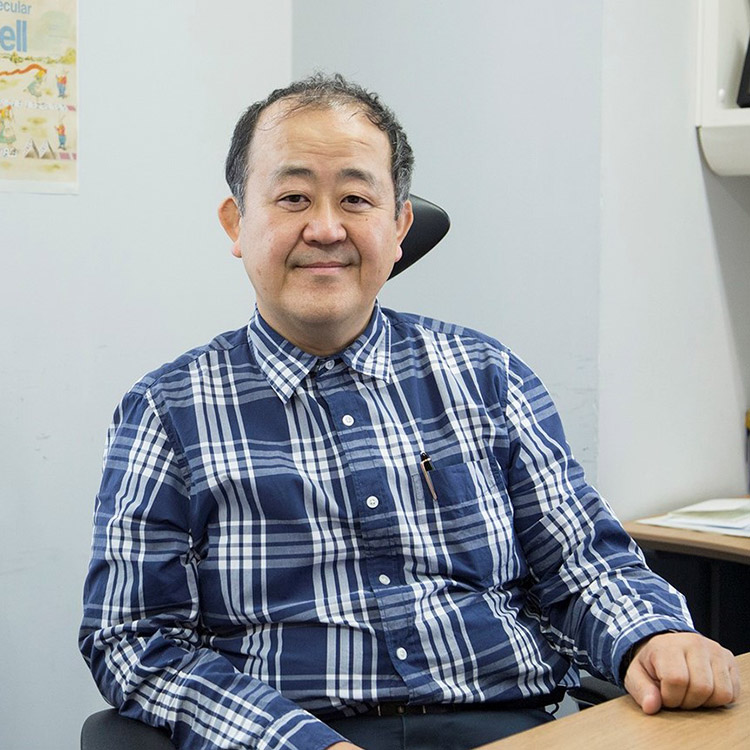
予防治療へのエピゲノムの関与と可能性
The epigenome, a new target for preventive medicine
●研究の概要を教えてください
私たちの研究室では肥満を背景とした高血圧、糖脂質代謝異常症、動脈硬化などの生活習慣病の分子レベルでの解明、画期的な予防・治療法の開発につながる基礎研究を行っております(図1)。私たちの体は中枢と末梢の代謝組織でホルモンや神経などでつながり、外界の環境に応答・適応していきます。さらに組織はいろいろな種類の細胞からなり、個々の細胞がそれぞれ特徴的な機能を果たしながら組織としての機能を果たしていきます。
私たちは特に脂肪組織に着目しております。脂肪組織は、過剰な栄養を蓄え必要な時にこれを分解してエネルギー源として供給する働きとともに、レプチンと呼ばれるホルモンを分泌して、中枢での摂食を制御し、また、女性の二次性徴に関与するなど内分泌器官としても重要です。また、寒冷の環境においては皮下脂肪組織の中から蓄積された栄養分を消費することで熱産生を行う細胞が出現し、活発に熱産生を行います(図3、4)。これは特に褐色化脂肪細胞とも呼ばれ、脂肪や糖をよく消費することから肥満・生活習慣病の治療標的として世界中で研究が進められています。
このような環境に対して生体が適応していく仕組みで重要なのが「エピゲノム」の考え方です(図2)。環境からの刺激は細胞内のシグナル伝達を経て核の中のゲノム上に化学修飾として記録され、細胞分裂を経てもこれが引き継がれることから、細胞レベルでの記憶システムを担っております。エピゲノムによって単一の受精卵ゲノムから200種類もの細胞が分化し各々アイデンティティーを保つとともに、先に述べた環境変化に対して、組織中の細胞の運命を変えることで組織の性質を変え、例えば脂肪蓄積から脂肪燃焼・熱産生、環境に適応します。私たちはこのエピゲノムがどのように生活習慣病の予防治療に関与しているか、取り組んでおります。
ホームページ:http://www.metab.med.tohoku.ac.jp/
プレスリリース:「エピゲノムによる環境への適応」に関する論文がNature Communicationsに掲載。
http://www.metab.med.tohoku.ac.jp/news/517/
朝日新聞デジタル「燃えやすい体脂肪に変える「スイッチ」マウスで酵素特定」
http://www.metab.med.tohoku.ac.jp/news/531/
読売新聞コラム「エピゲノム 仕組み解明を」星陵の学び舎から。
http://www.metab.med.tohoku.ac.jp/news/536/
海外のメディアにも取り上げられています。
ABC News 「Can being cold help you lose weight? 」
https://abcnews.go.com/Health/cold-lose-weight/story?id=54631686
プレスリリースEnglish
https://www.u-tokyo.ac.jp/en/utokyo-research/research-news/enduring-cold-temperatures-alters-fat-cell-epigenetics.html
●What is your research topic?
Our research topic is “the epigenome”. Epi means “on” so this epigenome is a higher-order system that regulates gene expressions from the genome. Epigenomics is a system pivotal for adaptation to environmental changes. We are especially focusing on lifestyle disease such as hypertension, glycolipid disorders, and atherosclerosis and vascular biology toward the development of innovative therapeutic strategies (Fig. 1).
We are particularly focusing on fat tissue (also called “adipose tissue”). Fat tissue contains fat cells (also known as adipocytes) that store nutrients as a form of tri-glyceride (i.e. fat), and when needed, breaks them down to dissipate energy for heat generation. Fat tissue is also important as an endocrine organ: fat cells secrete hormones such as leptin to control feeding through the central nervous system. Furthermore, under a cold environment, brown-like fat cells emerge in subcutaneous fat tissues that consume stored nutrients to generate heat. These have been named “beige fat cells,” and they actively produce heat (Fig.3, 4). Because brown and beige fat cells consume fat and glucose quite well, they are now being actively studied as a new therapeutic target for lifestyle-related diseases.
Epigenomics plays a crucial role in enabling living beings to adapt to environmental stimuli (Fig.2). Environmental stimuli are received at the cell surface receptor, transmitted via intracellular signaling pathways, and add chemical modifications to the genome as the epigenome in the nucleus. Epigenomic modifications are maintained through cell divisions, thereby playing a role as a memory system at cellular levels. Thus, the epigenomic system allows the generation of approximately 200 types of cells from a single fertilized egg. Each individual cell can preserve their own identities and are also capable of adapting to the given environment by changing cell fate (i.e. qualities and functions) in tissue, for example, from fat storage to fat burning cells for heat production to adapt to a cold environment. By further elucidating this system, we will develop ways to prevent and treat obesity and associated comorbidities.
Website: http://www.metab.med.tohoku.ac.jp/
Press Release: About “Epigenomic Adaptation to the Environment” published in Nature Communications.
http://www.metab.med.tohoku.ac.jp/news/517/
The Asahi Shimbun Digital: Identification of the “switch” enzyme that makes body fat flammable in mice
http://www.metab.med.tohoku.ac.jp/news/531/
Yomiuri Shimbun column: “Elucidation of Epigenomic Machinery” from “Seiryo School (Tohoku University, School of Medicine)”
http://www.metab.med.tohoku.ac.jp/news/536/
The international media has also covered the topic:
ABC News “Can being cold help you lose weight?”
https://abcnews.go.com/Health/cold-lose-weight/story?id=54631686
Press release in English
https://www.u-tokyo.ac.jp/focus/en/articles/a_00602.html
学際的でアットホームな研究室
A cozy interdisciplinary laboratory
●研究室はどのような雰囲気ですか?
留学生が多く学際的で、英語での会話も多いです。学部生も参画するなど興味ある学生は広く受け入れております。時折ホームパーティーなどを開きアットホームな雰囲気です。
分子生物学手法から遺伝子改変動物を使った生理学解析を行い、分子から個体の研究を行います。
●What is the atmosphere in your lab?
We have many international and multidisciplinary students in our lab, where you can also experience English conversation and research presentation. We are accepting students not only from schools of medicine but also from many other schools of life sciences if they are interested in our research. We occasionally have home parties.
We are studying the epigenome and metabolism, and lifestyle diseases including obesity, hypertension, diabetes, hyperlipidemia, and so on using molecular biology techniques and genetically engineered animals. We are currently interested in paternal and maternal inherited epigenomes.
「知りたい心」をエネルギーに、「運、鈍、根」が成功への秘訣
“Curiosity” is the energy for doing science and all three of “luck, not pursuing nearsighted benefit, and perseverance”, are the keys to your success
●進学希望者へのメッセージをお願いします
分野では当研究室のテーマに興味を持ち、「熱意と協調性のある大学院生」を募集しています。医学はもちろん、歯学・理学・工学・薬学・農学・獣医学部出身などライフサイエンス(生命科学)一般に学生諸君の参加を希望しております。来ていただいた暁には、「好奇心」をもってライフサイエンスに取り組んでいただきたいです。「知りたい心」がすべてのエネルギー源です。そしてあきらめない「運、鈍、根」が成功につながる発見の秘訣だと思います。サイエンスは真理のみが残ります。大事な発見をしたときの感激は忘れられません。好奇心をもち、サイエンスを追い求め、そして、医学生理学の発展に寄与していただきたいと願っております。
ちょっと長いですが、本稿末尾の「ヒールに徹して真実追及姿勢貫く」もご覧ください。
●Please give a message to students including what you expect from them.
We welcome enthusiastic, innovative, and cooperative students interested in our research. We welcome students not only from schools of medicine but also from other fields of life sciences that include dentistry, science, engineering, pharmacy, agriculture, veterinary medicine, and more. Once you join us, I urge you all to face science with “curiosity”. Curiosity is the source of energy and good luck. Go for it. “Luck, not pursuing near sighted benefits, and perseverance” are the key attitude that will lead you to success. I believe that only the “truth” remains in the history of science. I have never forgotten the exciting moments when I made important discoveries. I hope you will always be curious, never give up pursuing science, and thereby contribute to the progress of physiology, medicine, and life science. Though it is a bit long, please read my column, “Devote yourself to pursue the truth”, at the end of the article.
製薬・医療機器関連、食品関係、研究者、臨床医への道
Pharmaceutical, medical devices and food-related, researchers and clinicians
●修了後はどのような進路がありますか?また、修了生はどのように活躍していますか?
東北大学での卒業生はまだ巣立っておりませんが、これまで十数年以上研究室を主宰してきた中で酒井研究室としては、アステラス製薬を始めとした製薬関連の企業、GEヘルスケアなどの医薬機器関連の企業、森永などの食品関係の企業などに進まれた方、また、研究者としては教授や准教授、講師などになられています。もちろん臨床医として病院で活躍されておられる方もおります。
●What career paths are available to the students after they graduate? What are the graduates doing well there?
Although Tohoku University graduates have not left the nest yet, I having been running the Sakai lab for more than 17 years, and our graduates have been hired at pharmaceutical related companies such as Astellas Pharma, medical devices related companies such as GE Health Care, food related companies such as Morinaga, while other researchers have become professors, associate professors and senior lecturers. Of course, some of our graduates are playing active roles in the hospital as clinicians.
●病院や企業に勤務しながらの修学は可能でしょうか?
可能です。これまでの研究室を主宰してきた間、臨床の教室や製薬企業(住友、アステラス製薬)からの大学院生を受け入れてきており、立派な論文を発表して博士を取得されております。また、他の大学の大学院生を受け入れて研究を指導させていただくことも多くあります。
●Is it possible to study while working at a hospital or in a company?
Yes, it’s possible. While running our department over the years, we’ve accepted graduates from clinical research labs and pharmaceutical companies (Sumitomo and Astellas Pharma). They have published fine papers and earned their PhD. Also, we accept and supervise graduates from other universities.
●東北大学の良いところは?
研究第一をモットーとする本学医学系研究科においては、分子生物学並びに動物解析に必要な機器がコアファッシリティーに大変充実しており、大概の実験をすることができます。総合医学として包括的な分野を擁しており、各専門家に接することが可能です。
●What are the advantages of Tohoku University?
Our motto at Tohoku University is “research first”; our Graduate School of Medicine is equipped with a wide range of the necessary equipment for molecular biology and animal analysis in the core facility, so most of the experiments can be performed here. Also, as our school embraces comprehensive fields such as general medicine, you can consult specialists in each fields.
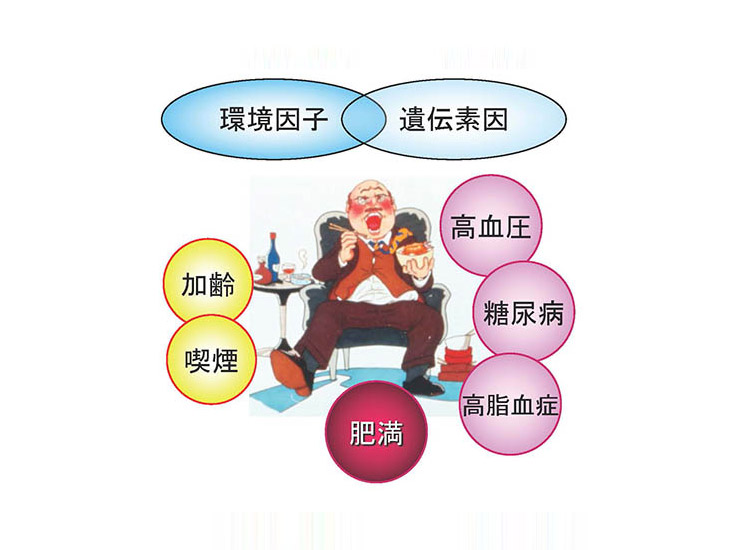 図1 生活習慣病発症には遺伝素因と共に生活習慣(環境因子)が、発症進展に関与
図1 生活習慣病発症には遺伝素因と共に生活習慣(環境因子)が、発症進展に関与
(fig.1)environmental factors and genetic factors are both important for the onset of lifestyle diseases.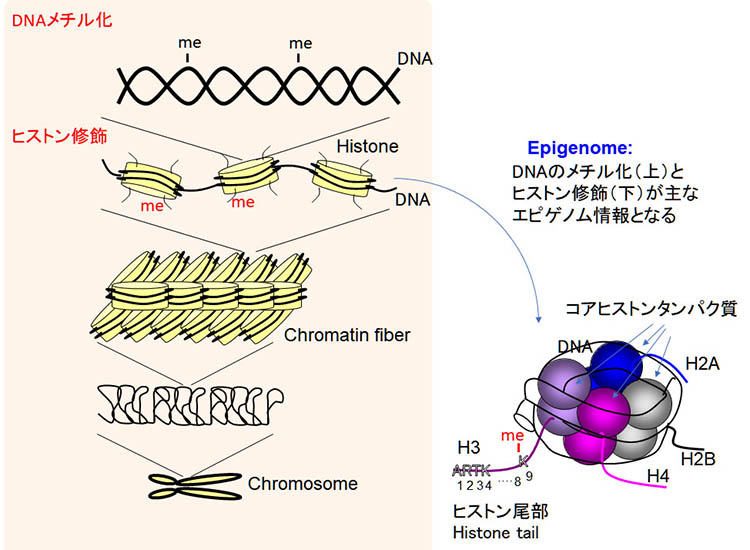 図2 エピゲノムとは?
図2 エピゲノムとは?
塩基配列によらない遺伝子発現調節機構。ヒストン尾部は、メチル化、アセチル化、リン酸化、ユビキチン化、SUMO化修飾を受ける。修飾パターンは、クロマチン構造の変化に関与する。
(fig.2) What is the epigenome?
It’s a DNA sequence-independent mechanism for the regulation of gene expressions. Histone tails can undergo methylation, acetylation, phosphorylation, ubiquitination, SUMOylation and so on. Modification patterns are related to changes in chromatin structures.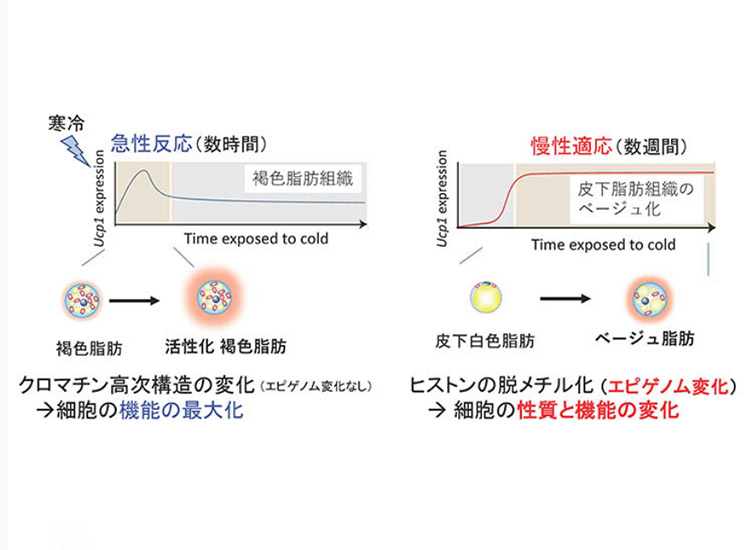 図3 エピゲノムを介した環境への適応機構
図3 エピゲノムを介した環境への適応機構
生体は環境の変化に対し、急性期は細胞機能を最大化させ、慢性期には細胞の質の機能の変化を介して環境に適応する。脂肪細胞は、生活習慣病の新たな標的として注目されている。(Nature Communications 2015, 2018, Nature Reviews 2016)
(fig.3) Adaptation to the environmental stresses via the epigenomic mechanisms
When animals are exposed to environmental stresses such as cold temperature, cells respond to it by maximizing their functions in the acute phase. In the chronic phase, when the environmental stress persists, cells in tissues change their characteristics to function for the adaption to the given environmental stress via epigenetic mechanism. Adipocyte is drawing attention as a new therapeutic target of life style diseases. (Nature Communications 2015, 2018, Nature Reviews 2016)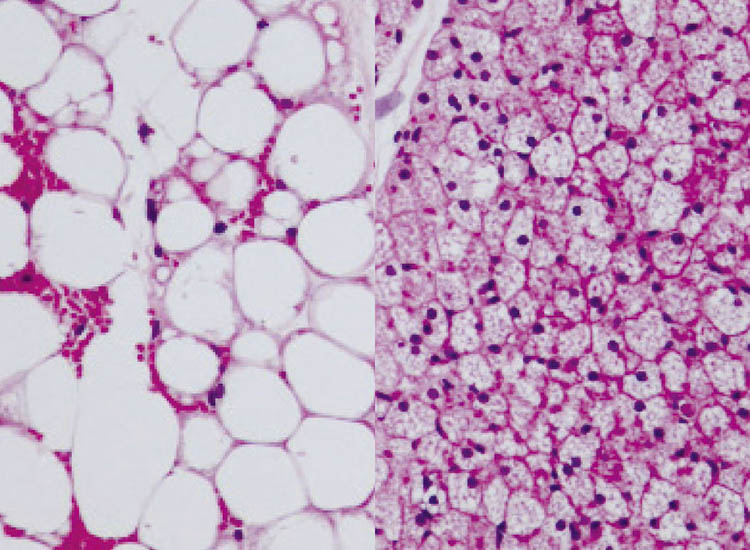 図4 脂肪を溜め込む白色脂肪細胞(左)と脂肪を燃やす褐色脂肪細胞(右)
図4 脂肪を溜め込む白色脂肪細胞(左)と脂肪を燃やす褐色脂肪細胞(右)
(fig.4) Major role of white fat cell is storing fat (left) and that of brown fat cell is burning fat (right)
コラム1:ヒールに徹して真実追究姿勢貫く
私の師であられるGoldstein JL博士とBrown MS博士は冠動脈疾患の罹患が高く米国の社会問題となった時期に、動脈硬化研究をはじめました。悪玉コレステロールとも呼ばれるコレステロールの主要な運搬体である低密度リポタンパク質(LDL)受容体を発見するとともに、その遺伝子異常が若年性の動脈硬化症を引き起こすことを発見しノーベル賞が授与されました。彼らの研究はとてもすごく私は大きな影響をうけました。彼らの研究は、科学を超えたアート(芸術)でした。あたかも白い大きなキャンバスに艶やかな絵を描いていくようなものでした。しかもジクゾーパズルをキッチリとはめ込んでいくような精密なものでした。大事なことは地味であってもとことん証明し次のステップへ進んでいくという、本当に科学者のあるべき姿に私は感銘しました。今も私はこのような研究を目指して頑張っております。
さて、そんな研究室に私は留学しましたが、その当時いきなり大変な経験をしました。それは、彼らの仮説(願っていた結果)と私が実際に出す結果が違う、ということでした。当時、コレステロール制御因子SREBPを活性化する変換酵素がコレステロール制御の重要な因子として研究室を上げて追い求めていました。そして、その候補となるタンパク質が、まさしくSREBPを発見した研究員によって見出されていました。両博士はそれが本物であることを強く望んでいたのですが、私の出す結果はすべてそれを否定するものでした。私は完全に悪役です。しかし、めげずに否と言い続けました。しかし、結局その他のデータからもその見出されたものは求めていた変換酵素ではないという結論に至りました。しかしながら、コツコツと研究を重ね、その3年半後に私は前駆体SREBPを活性化する本当の活性化酵素S1Pを見出しました。その時の感激は忘れられません。サイエンスは真理のみが残ります。そして今その内容は教科書に載っており、私は学生に講義しております。好奇心をもち、サイエンスを追い求め、そして、医学生理学の発展に寄与していただきたいと願っております。
◆下記の当分野のサイトもご覧ください!
◆細胞生物学の世界ではトップのセル誌が40周年を迎えるにあたり、ランドマークになった論文を25報程選んで解説付きで特集しています。当時の論文ですが20年たって、私が当時掲載した論文がこれに選ばれました。
Column1: Go for the Truth, DO NOT go for a compromise
My former supervisors, Dr. Goldstein JL and Dr. Brown MS, started research on atherosclerosis in the 1980s. At that time coronary artery diseases were prevalent and a social concern in the US. They devoted themselves in working on this issue as physician scientists and discovered the low-density lipoprotein (LDL) receptor, the receptor for the main carrier of cholesterol containing lipoprotein called LDL (also known as atherogenic lipoprotein). They further found that its genetic defect causes familial hyper-cholesterolemia, a disease that causes juvenile atherosclerosis and a high incidence of cardiovascular diseases. These discoveries won them the Nobel Prize in 1985. Their research had a tremendous influence on me; it was just like an “art,” far beyond a “science.” In their lab, I felt as though I was drawing beautiful pictures on a large white canvas under their supervision. Their science was very precise, transparent, and very clear, just like putting the multiple pieces of a jigsaw puzzle together, although they were really strict on the data and tough on us. We were able to eventually discover what we were looking for based on a hypothesis. It was astonishing to me how thoroughly they devoted themselves and put their energy into the science.
However, when I joined them in 1994, I started lab work in the midst of a very tough situation. At that time, transcription factor SREBP, which regulates intracellular cholesterol homeostasis, was their main project. Especially, discovering the converting enzyme that activates precursor SREBP was most important. A candidate protein had already been found by a postdoc who discovered SREBP. Both doctors really wanted to believe that this was it, and my project was to prove it. However, all the data I obtained was against their hypothesis. I was a villain (bad guy) for them! But I insisted on my opinion that the candidate protein was not the one we wanted and it eventually turned out that I was correct. Three and a half years later, I succeeded in discovering the genuine “SREBP converting enzyme” that activates precursor SREBP, namely S1P. I can never forget that exciting moment. Only the truth remains in the history of science. This SREBP pathway is now described in the textbooks! I am lecturing to my undergraduate as well as to graduate students. I am happy that I can tell them this story with excitement and the vivid memories of what I went through for this discovery in Dallas. I hope all students will approach the core science with curiosity and to contribute to the advance of medical science.
◆Please take a look at our site! Click the following URL.
◆The most authoritative journals for cell biologists, Cell Press celebrated its 40th anniversary by introducing 25 landmark papers with featured commentaries. Twenty years have passed, and my paper from those days was chosen as one of these.
コラム2:春の到来を告げる「かめろー」との生活
私たちの研究室では、飢えと寒さに対抗するために備わっている脂肪組織の研究をしております。生理学的にはこれを適応型熱産生 adaptive thermogenesisといいます。体温を維持するために、メタボリズム(代謝)によって体内に蓄積された燃料は熱とATPに変換されます。
ところで、ペットはカメを飼っています(写真下、当時5-year old)。思い込みで「カメ郎(カメロー)」という名前を付けてしまいましたが、どうやらその後何年かしてペット屋さんに見てもらったところ女の子だったようです。でもいまだに名前は 「かめろー」です。恒温動物でない爬虫類のカメは寒いところでは体は冷たくなり冬ごもりもします。毎年家のどこかで冬ごもりしているのですが春先になるとガタッという音がして(カメの甲羅は固くフローリングを歩くと革靴で歩くような音がします。)動き出し、春の到来を感じます。飼い始めた当初は赤ちゃんの手のひらサイズの可愛い大きさでしたが13年たったいまは漬け物石のような大きさです。家の中を自由に歩くことを許可してから、好きなように家の中をカメ歩きしています。体温を維持する機構がないのか触ると冷たいです。恒温動物はどんな環境温度でも俊敏に動き、外敵から守るため体温を一定にし、酵素活性が37℃という至適温度で働くためと理解しておりましたが、いったいどうして低温で爬虫類(変温動物)の酵素活性が保たれ、心臓も含め体を動かす必要なATP供給されているのか謎です(勉強不足)。また、「うさぎとかめ」、というくらい動くのが遅いのかと思いますが、夏のカメ歩きは早いのです。特に餌をあげるときは遠くからバタバタと走ってきます。カメはなかなか愛くるしく、フレンドリーです!といいつつ、さすがに変温動物ですので寒いときは遅いです。「うさぎとかめ」は冬期のお話しかも知れませんね。
Column 2: My life with “Kame-roh”, telling the arrival of spring
Cold and hunger are two major threats to homeothermic animals. Adipose tissue functions to protect animals from such environmental stresses. Heat production to maintain body temperature in cold environments is called “adaptive thermogenesis”. Stored fat in fat cells (adipocytes) is broken down to generate fatty acids, which circulate in the blood stream, and are taken up for ATP production or heat generation in oxidative tissues such as muscles, liver, and brown adipose tissue.
By the way, I have a pet named “Kame-roh”. She is a turtle (see the photo, she was five years old at that time). “Kame” means turtles in Japanese and the suffix “roh” means it’s a boy. However, a few years ago, when I took him to the pet shop, the veterinarian said that Kame-roh was female, but she is still called Kame-roh. Turtles are not thermostatic reptiles; therefore, they reduce their body temperatures under cold environments and become less active in winter. When winter comes, she hides herself in dark places in my home and spends the winter time there every year. This is reminiscent of the “torpor” or “hibernation” of small animals or bears. By reducing their body temperature and activities, which are mediated by metabolism, hibernating animals consume minimum energy throughout winter. Winter time goes by and it becomes warmer, little by little, she resumes her metabolism by moving, making a rattle sound; her shell is so hard that when she moves, she makes sounds as if people are walking in leather shoes. The rattle sound is a wakeup call that let us know spring has come!
When she came to my home, she was as little as a baby's palm size, but now, she's as big as the stone used in Curling, one of the sports in Olympic game (in which players slide stones on a sheet of ice toward target area)! Yet, she cannot maintain her body temperature against cold environments; she feels cold when I touch her. Thermostatic animals can keep constant body temperature and the metabolic enzymes work best at 37 degrees Celsius, which is why they can move fast under any environmental temperature. This helps them trigger their “fight-or-flight” response in the face of enemies. I do not know how enzymes in reptiles (poikilotherm) can work at even lower body temperatures to produce the ATP for them to move, or at least for their hearts to move. I need to study this more.
Well, you might suppose that turtles walk slowly as in the story of "The Tortoise and the Hare", one of Aesop's Fables. Did you know that the turtle walks pretty fast in summer? She approaches me very fast when she wants to be fed. Now you understand how lovely and friendly turtles are, I guess, and she walks very slowly in winter indeed. Perhaps "The Tortoise and the Hare” fable is a story set in winter?

- PROFILE
- 医科学専攻
- Medical Sciences
- 分子代謝生理学分野 教授
- Division of Molecular Physiology and Metabolism Professor
- 酒井 寿郎
- Juro Sakai
1988年東北大学医学部卒、仙台市立病院で内科研修の後、大学院に進学(旧第二内科学講座)、1994年学位取得。テキサス大学Goldstein &Brown 博士(1985年のノーベル生理医学賞受賞)の研究室に留学。コレステロール制御の要となる酵素を発見。1998年帰国、岩出山病院内科医長、腎高血圧内分泌科助手を経て、2001年ERATO柳沢オーファン受容体プロジェクトグループリーダー、2003年東京大学特任教授、2010年 東京大学教授。2017年より現職(東北大学教授 医学系研究科)。
He graduated from Tohoku University School of Medicine in 1988. After his residency in internal medicine in Sendai City Hospital, he entered the Graduate School of Medicine of Tohoku University (the former Department of 2nd internal medicine). After he graduated and obtained his PhD degree in 1994, he started his postdoctoral fellowship under 1985 Nobel Prize laureates Drs. Goldstein & Dr. Brown’s lab in University Texas Southwestern Medical Center. During his stay in Dallas, Dr. Sakai found the converting enzyme of SREBP, a key transcription factor of cholesterol biosynthetic and uptake pathways.
He came back to Japan in 1998 and worked as a chief physician in internal medicine at Iwadeyama Hospital. He became an assistant professor in the Tohoku University Hospital (Nephrology, Hypertension and Endocrinology Department) in April 2000. In December 2001, he became a group leader of the ERATO Yanagisawa Orphan Receptor Project and in January 2003 he was appointed project professor at the University of Tokyo, and became a full Professor at the University of Tokyo in 2010. Since 2017, he has also become a full professor in his current position (Professor, Tohoku University Graduate School of Medicine).
jmsakai*med.tohoku.ac.jp (「*」を「@」に変換してください。)